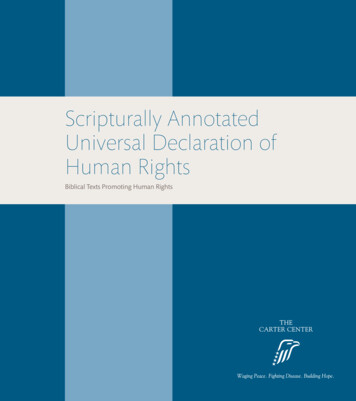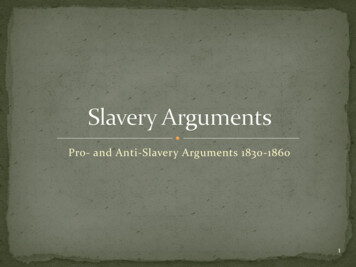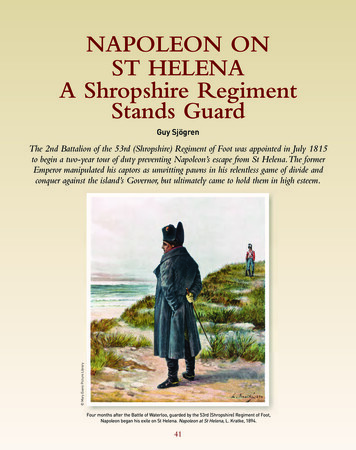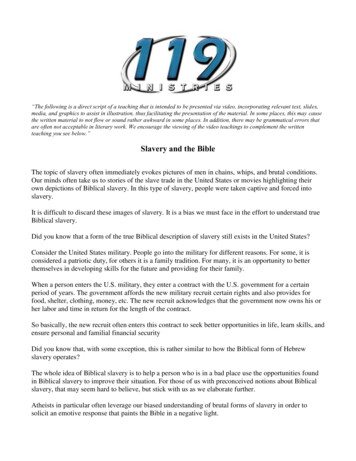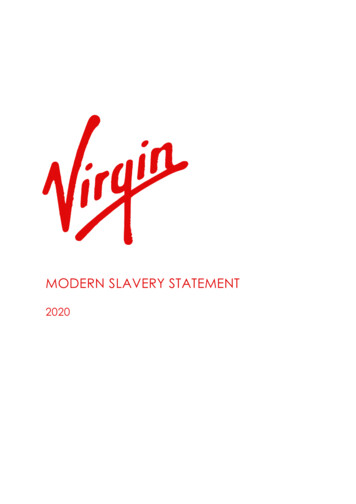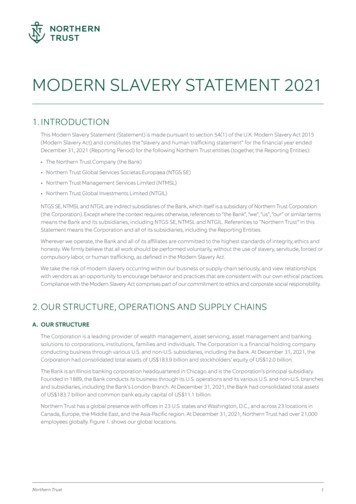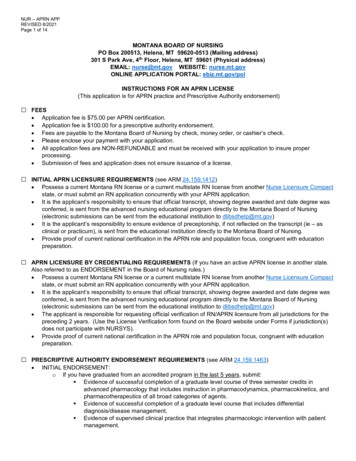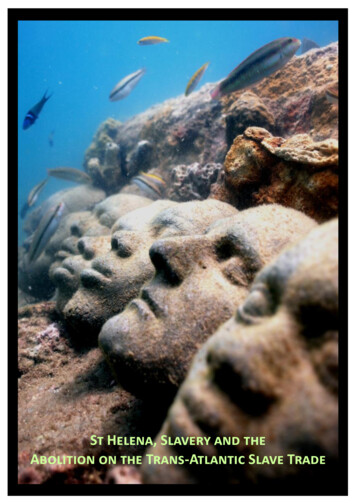
Transcription
St Helena, Slavery and theAbolition on the Trans-Atlantic Slave Trade
ContentsSt Helena, Slavery and the Abolition on the Trans-Atlantic Slave TradeIntroduction3Slavery on St HelenaSlavery on St Helena4Captured6The Slow End to Slavery on St Helena8Emancipation of Slaves on St Helena11St Helena and the abolition of the trans-Atlantic Slave TradeStopping the International Slave Trade14Freeing Captive Souls17Liberation on St Helena20Liberation Beyond St Helena22St Helena’s Achievements24Liberated African Cemeteries26What makes a Saint?28EUROTAST29Reference & Acknowledge31Front and back cover photographs courtesy of Grenada Board of TourismResearch by Barbara B. George. Further researched and written by Lucinda Caesar.Booklet compiled by Lucinda Caesar.Printed by Museum of St Helena 2012Copyright Museum of St HelenaAll rights reserved. No part of this publication may be reproduced, stored in a retrieval system, or transmitted, inany form or by any means, electronic, mechanical, photocopying, recording or otherwise, without the priorpermission in writing of the copyright owner.2
St Helena, Slavery and the Abolition on the Trans-Atlantic Slave Trade(Reynolds 1985)3Slavery“In the beginning, gold was the magnet thatattracted Europeans to Africa. It was soonfollowed by ivory, pepper, beeswax, gum and theskins of tropical animals. Yet for well over threecenturies, it was a trade in human beings thatcemented the continents of Europe, Africa, andthe Americas together in a commercialrelationship. Fuelled by the demand for humanlabour in European enterprises in the New World,the transatlantic slave trade would bring millionsof Africans to bondage in the Americas from eightmajor slave-trading regions – Senegambia, UpperGuinea, the Windward Coast, the Gold Coast, theBight of Benin, the Bight of Biafra, the Congo andAngola. At markets situated along a great arc ofthe west coast of Africa, from Senegal in thenorth to Angola in the south, ships flying the flagsof Spain, Portugal, Holland, England, France andDenmark all took on cargoes of African captives.Thus began a journey to colonies in the Americas,where slave labour would be used to build andsustain mining operations and plantationsproducing lucrative agricultural commodities –tobacco, cotton, coffee, rice and most of all,sugar.”
Slavery on St HelenaSt Helena, Slavery and the Abolition on the Trans-Atlantic Slave TradeBy the 1500s it was generally realized that black slaves wereessential to the production of goods needed for Europeancolonization, as this large and controllable workforce was the mostreliable and efficient. So, it is no surprise that slaves came with StHelena’s first settlers in 1659.Like other colonies, these settlers, the employees of the East IndiaCompany, brought with them indentured servants to work in theCompany’s Plantations, and slaves to work in the production ofhigh market value crops, such as sugarcane and coffee, and as hardlabour. The East India Company soon placed restrictions on thefurther importation of slaves, as there was general fear that theirnumbers would exceed those of the white ‘or more civilisedcommunity’.An 1800 depiction, idealising the abduction of individuals for enslavement.4
St Helena, Slavery and the Abolition on the Trans-Atlantic Slave TradeA little after, a convenient local law was passed requesting that‘each Madagascar ship calling for stores should becompelled to land a black, either man or woman(whichever was decided by the Governor), for servicein the Company’s Plantations, as payment forcustoms and dues’.Slave Shackles.5Slavery on St HelenaAs the cost of white labour increased during this period, due towage advancement in England, permission was again granted toimport slaves on the condition that the purchaser should maintaina white man for the militia, or, in default, the Slave Proprietorwould pay the East India Company 10 shillings for each slaveowned.
CapturedSt Helena, Slavery and the Abolition on the Trans-Atlantic Slave TradeDuring the Atlantic Slave Trade, Africans were wrenched frombattlefields, farms, and villages, from river houses and coastalcrafts, from judicial proceedings and caravan routes. Thesecaptives were eventually sold to European buyers on the coast.Villages burning after the abduction of its residents.However slaves were procured, they were always brought to thecoast of Africa for sale. Chained to prevent their escape, many firstpassed through various markets and masters, some being usedalong the way as domestics or as field hands during the planting orharvesting season.The exportation of abductees to Slaver Vessels.6
St Helena, Slavery and the Abolition on the Trans-Atlantic Slave TradeThe transatlantic slave trade was driven by the need for labour inEurope and the Americas, which led it to be called the Europeanslave trade. It also has been termed the ‘triangular trade’, as thetrade route often involved a voyage of three legs: from Europe toAfrica where trade goods were exchanged for slaves; on to theAmericas where slaves were sold for cash, promissory notes, oragricultural products; then back to Europe, where the New Worldcommodities would be sold.On arrival at their destination, slavers would sell their cargo. Oneform of sale was known as a ‘scramble’, when prospective buyersrushed on board to select slaves they liked at a fixed price. For thecaptives, a scramble sale could be a frenzied, terrifying event asbuyers frantically grabbed and roped their quarry. Havingdisposed of its slave cargo, a ship would often return to Europewith colonial products such as coffee, sugar, and cotton.Source: Reynolds 20027CapturedEuropean ship captains and slavers who arrived at the Africancoast were required to obtain a trade licence, typically by payingfees or purchasing a number of slaves at a specified price from thelocal chief. The fees and numerous presents European slavetraders were obliged to give Africans to pave the way for businesswere governed by complex protocol and were subject to change atthe behest of the local people. Europeans strove to comply withsuch demands to avoid jeopardising their ability to trade.
The Slow End to Slavery on St HelenaSt Helena, Slavery and the Abolition on the Trans-Atlantic Slave TradeThe credit for abolishing slavery on StHelena belongs to Sir Hudson Lowe,and whatever history may sayregarding his actions as guardian ofNapoleon, nothing can detract from thepraise that is his for carrying out thishumanitarian reform in a communitygiven over entirely to the practice ofslavery.Sir Hudson Lowe, Governor of St Helena (1816-1821)Although Britain had abolished slavery in 1807, the colonies hadnot, St Helena included. Although the island did have a populationof freed slaves, 329 from a total population of 1560 enslavedindividuals. Their freedom was granted as the result of an edict in1673 , when the EIC decided that;“all Negroes that shall make profession of theChristian Faith and be baptised shall, within 7 yearsbecome free”The enslaved working on plantations, hundreds of miles from their homeland.8
St Helena, Slavery and the Abolition on the Trans-Atlantic Slave Trade“On 24th August 1818, Sir George Bingham, the commanderof the troops on the island, had just left the Magistrate’sCourt where he had been presiding when his eye fell upon apoor slave girl, about fourteen years old, limping down theroad with blood dripping from fresh wounds on her arm andback which had been produced by a whip.Sir George, with his well-known kindness of heart andchivalrous disposition, was shocked at the distressing sight,and inquired who had been guilty of such inhumanity. Hewas told that the injuries had been inflicted by the girl’sowner, Mr Charles De Fountain. Sir George at oncereturned to the court, ordered Mr De Fountain to bebrought before him, and inflicted the statutory fine of 2.Then, addressing those about the court, he gave vent to hisindignation in violent terms, and said he only wished he hadit in his power to make the fine 40 and to order Mr DeFountain to receive the same treatment he had meted outto the poor slave.Mr De Fountain, callous to the last, complained to theCouncil of the injurious terms in which he had beenaddressed by Sir George in the hearing of others, but SirGeorge repeated in the Council every word he had said, andstated that he did not withdraw or regret a single word thathe had uttered in anger in the Court House.The whole matter made a considerable commotion, and SirHudson Lowe immediately gave notice that he would againbring up the whole question of slavery at the next CouncilMeeting. Soon after, the whole Island agreed voluntarily to9The Slow End to Slavery on St HelenaLieutenant-Colonel Sir Hudson Lowe, as Governor of St Helena, hadfrequently raised the issue of abolition, it was discussed by the StHelena Council, but with no result. The brutal beating of a youngSlave girl in August 1818 leading to a change in attitude and theend of Slavery on St Helena.
The Slow End to Slavery on St HelenaSt Helena, Slavery and the Abolition on the Trans-Atlantic Slave Tradegive up the practice of slavery, and Sir Hudson had justcause to be proud of his achievement.” (Chaplin 1919)In his fight to stamp out slavery on St Helena, Sir Hudson Lowe putforward a proposal that the island should adopt the practices ofCeylon (now Sri Lanka), that all children born to slaves wereclassed as free. Later in that year the Governor and Councilapproved a law declaring that‘all children born of a slave woman from and afterChristmas Day 1818, were to be free, but to beconsidered as apprentices to the proprietors of themothers if males, until the age of eighteen, and iffemales, until sixteen; and that the masters andmistresses were to enforce the attendance of freeborn children at church and the Sunday schools’.These measures meant that, over time, slavery would die out, butfor the Honourable Court of Directors of the East India Company,the eventual end was not soon enough. St Helena was the only‘spot under their government where slavery still existed’ (Gosse1938).10
St Helena, Slavery and the Abolition on the Trans-Atlantic Slave TradeHonourable Court of Directors of the East India Company19th December 1826Following the orders of the Honourable Court of Directors of theEast India Company, the St Helena began the process toemancipate its entire slave population.11Emancipation of Slaves on St Helena“the speedy and entire abolition ofslavery is essential to the welfare of theisland. Emancipation should be securedthe moment the slave understands andappreciates the blessing, and the means ofinstruction should be steadfastly andzealously pursued at the cost of Government.Humanity however should not interfere withsubstantial Justice and the Proprietor shouldbe secured the value of his slave wheneverdeclared free. This value to be fixed, notarbitrarily, but by a disinterested committee. Incases of good character we authorize you toadvance on Loan to the slave without Interest, theprice of his Freedom.”
Emancipation of Slaves on St HelenaSt Helena, Slavery and the Abolition on the Trans-Atlantic Slave TradeBy the 1st January 1828, after having valuedthe island’s 869 strong slaves population, at 37,639.00,the Honourable Court of Directors of the East India Companyauthorised St Helena’s Governor and Council to proceed with theirproposed method of emancipation, as they had outlined four yearsbefore, these were:1.To afford emancipation in the course of 5 years to thewhole slave population, excepting only a few dissolute andworthless members of it, by pecuniary advances frommoney on loan to the slave.2.To effect the emancipation by dividing the slaves intoclasses according to their character and valuation, and byemancipating a proportion of each class every year; theselection to be by Lot.3.Government should maintain the general feeling that ‘every shilling which a slave could earn or obtain washoarded with a view to the eventual acquisition of thisblessing’.4.To proceed without delay to divide the slaves into classesand to purchase the manumission of 1/5th every year, thepurchase money to be considered as a loan to the slave,repayable by instalments without interest.Emancipation did not mean that the island’s resident slaves weretruly free. Those who were able to pay their loan were very few.The majority who could not were punished by being advertised forhire.12
St Helena, Slavery and the Abolition on the Trans-Atlantic Slave TradeRobert Patton, Governor 1802-1807, “who hit uponthe novel conceit of rewards or medals as an inducement to good behaviour. Medals so awardedwere inscribed, ‘Honest Faithful Diligent Sober’, andif a slave should win one of these converted prizesin three successive years, he did not, as might havebeen expected, received his freedom but only ‘havehis merits completely established’” (Gosse, 1938).13Emancipation of Slaves on St HelenaA final ordinance created in 1839, during the suppression of theinternational slave trade clarified this issue and all were truly andlegally freed.
Stopping the International Slave TradeSt Helena, Slavery and the Abolition on the Trans-Atlantic Slave TradeSome North American States started the movement towardsabolition and were followed by Denmark and other Europeancountries, but it was Britain taking the lead. During the 1800s,public opinion in Britain favoured the end of slavery and in 1807the importation, to Britain, of African slaves was officiallyoutlawed.Britain’s powerful Royal Navy began patrolling the Atlantic. Manygovernments disputed Britain’s right to impose British law onvessels flying other flags, but some South American nations, notwanting to risk disrupting their maritime commerce with England,quickly jumped on the anti-slaving bandwagon: slave imports werebanned in Venezuela in 1811 and in Colombia and Argentina in1812. None of these nations had a large demand for slave labour.Brazil, by contrast, continued to require tens of thousands of newlyarrived Africans each year, as well as its existing population, tooperate sugar and coffee plantations.HMS Arab in pursue of a Slaver14
St Helena, Slavery and the Abolition on the Trans-Atlantic Slave TradeBritain’s task was not easy and became much more difficult as theslavers changed their tactics. They started to use little vessels inplace of large commercial ships. The brigs were easier to handleand trickier to find. For the slaves, conditions were worse as theywere packed even more tightly into these small brigs than into thelarger ships.Plans and Sections on aSlave Ship15Stopping the International Slave TradeSpurred on by ever-increasing pressure from abolitionists, in thefirst two decades of the nineteenth century Britain began pursuinganti-slaving treaties with the other maritime European nationswhose flags had flown over slave ships for centuries. Britain, nowthe great maritime power of the time, became the head of theantislavery movement controlling thousands of kilometres of theWestern African coastline.
Stopping the International Slave TradeSt Helena, Slavery and the Abolition on the Trans-Atlantic Slave TradeIn 1840, Britain extended its efforts to St Helena. Before this time,slavers could operate without interference in the SouthernHemisphere, as the treaties between the British and Portuguese orBrazilians only forbade trade north of the Equator. During the 1820s,the number of military ships policing the seas was quite small andinadequate but this was put right by increasing the numbers untilthere was a reasonable force to patrol the area.Slaves ‘packed’ for shippingSt Helena Island was chosen to become the base of the British WestAfrican Squadron and the seat of a Vice Admiralty Court. It was verywell located to do so; sited in the middle of the ocean the island wasan easy position to access from the Angolan and South Americancoasts, in a relatively short time. Not as well located, smaller andmore recently settled, Ascension Island played a less important role.Source: Delacampagne 200216
St Helena, Slavery and the Abolition on the Trans-Atlantic Slave TradeThe Slaver ’Sunny South’ alias Emanuela surrendering to H.M. Brisk17Freeing Captive SoulsIn 1840, the British West African Squadron was stationed at StHelena, their job was to suppress the slave trade by enforcingBritain’s abolition of slavery. A Vice Admiralty Court was alsoestablished to try those pursuing the slave trade on the high seas.H.M. Brisk, H.M. Fantom and H.M. Waterwitch and later many otherHM Cruiser captured many slaver ships enroute from the West andEast of Africa to the Americas.
Freeing Captive SoulsSt Helena, Slavery and the Abolition on the Trans-Atlantic Slave TradeThe first naval vessel to capture a slaver was H.M. Waterwitch.She was the most well known during the entire anti-slave tradestruggle based in St Helena. The slaver she captured was theCabaka, a vessel sailing under Portuguese colours, fortunately itlacking any papers giving it the right to protection under thePortuguese flag. The Cabaka was seized on the 14 March 1840close to Ambriz, in the Northern part of Angola. Lieutenant HenryJames Masson, commander of the H.M. Waterwitch reported tothe Vice Admiralty Court that,‘the Cabaka made every effort to avoid capture,endeavoured to escape, after being detained and did notsurrender until being repeatedly fired at’. (Letters of theVice Admiralty 1840)The H.M. Waterwitch was themost active British WestAfricanSquadron havingchased and brought into StHelena 43 slavers.Amemorial to her crew, wholost their lives while servingoff the coast of Africa, standsin the Castle Gardens,Jamestown.H.M. Waterwitch Memorial18
St Helena, Slavery and the Abolition on the Trans-Atlantic Slave TradeFreeing Captive SoulsThe inscription on the H.M. Waterwitch Memorial19
Liberation. on St HelenaSt Helena, Slavery and the Abolition on the Trans-Atlantic Slave TradeIndividuals packed onboard a Slaver‘I picked myway from endto end in orderto avoid treading uponthem, was thickly strewn with thedead, dying and starved bodies,. . . A visit to a full freightedslave-ship is not easily to beforgotten; a scene so intensifiedin all that is horrible almost defiesdescription’ (Mellis 1861).The vessel he writes of was one hundred tons burden, andcontained nearly one thousand souls. They had been closelypacked for weeks in the ‘hottest and most polluted ofatmospheres’.“The arms and legs of the poor creatures were worn downto about the size of walking-sticks and as they were passedover the ship's side, some living, some dead, others dying, itwas hard to believe they really were human beings. Manydied as they were in the act of being passed over the side ofthe ship” (Mellis 1861).Captured Slavers tried and condemned by the Vice Admiralty Courtwere sold and broken up, while their human cargos were taken toDepots at Rupert's Valley, Lemon Valley, and High Knoll. Here theywere fed, clothed and cared for until they had sufficientlyrecovered to continue their journey to British West Indies or CapeTown.20
St Helena, Slavery and the Abolition on the Trans-Atlantic Slave TradeLiberation. on St HelenaA sketch plan of the Liberated African Depot at Lemon ValleyDuring the short period of nine years between June 9, 1840, andSeptember 30, 1849, 15048 slaves were received by St Helena. Forover 4900* St Helena, was their final resting place, most of theremaining Liberated Africans were shipped to Jamaica, BritishGuiana, Trinidad and the Cape of Good Hope, where they would beemployed as labour. This practice continued throughout theabolition of the Slave Trade.*This number is specific to the period 1840 to 1849; St Helena Island is final resting place ofthousands of Liberated Africans, beyond the numbers described here.21
Liberation Beyond St HelenaSt Helena, Slavery and the Abolition on the Trans-Atlantic Slave TradePrior to large numbers arriving, it was agreed to assimilate thefreed slaves; St. Helenian Merchants and Farmers were givepermission to employ liberated Africans as servants, on thecondition that they clothed and fed those individuals chosen. Anumber became so fond of their St. Helena masters and mistressesthat they decided to remain on the island instead of seeking theirfortunes elsewhere.During the late 1800s Mrs. Emily Jackson was able to interview some ofthe last remaining Liberated Africans.“Of the all the Navy Squadron the most remembered was the H.M. Styx, H. M. Conquest, H. M. Waterwitch and the H. M. Cyclops.The H.M. Cyclops was spoken of by one of the old men still living,and there are five I was able to photograph who came inher; two men and three old women, who are now in thepoorhouse. The men, although over seventy, are still able toearn a little, but the women are helpless, and almost blind,being all of good age. The taller man is named DukeWellington, the other Blinker.Wellington says they were brought here in the Cyclops, andthat soon after they arrived some officers came to Rupert'sto choose servants, and, as he relates, Captain GeorgeWoolet, St. Helena Regiment, took him, Major Piggott choseBlinker, and Colonel Ross, an officer, chose Caesar. Whilethey lived in tents at Rupert's, with only rations: biscuit,rice, salt meat, and fish, once they became servants theylived in the mess-house and ate like soldiers. During the past twoyears many have died; Old Cappy, who earned a living to thelast by fetching watercress down for the shipping, Jack FryPumpkin or John Janische (his master's name) and TobyMorrison, here again the mas-ter's name, were for manyyears well known to all ” (Jackson 1903).22
St Helena, Slavery and the Abolition on the Trans-Atlantic Slave TradeLiberation Beyond St HelenaLiberated Africans living on St Helena during the late 1800s.23
St Helena‘s AchievementsSt Helena, Slavery and the Abolition on the Trans-Atlantic Slave TradeAn important part of the suppression process was the formal trial andcondemnation of captured slave ships by the High Court of Admiraltyof England and Vice-Admiralty courts existing at Sierra Leone, StHelena, Barbados and the Cape. Operating in concert with MixedCommission (bi and multi-national) courts set up under treaties withSpain and Portugal at Sierra Leone, and later Loanda, Rio, Surinamand Havana, gave St Helena the right to seize any vessel engaged inthe Slave Trade and to bring the same adjudication as if the vesseland cargo were the property of Britain.Portuguese Map dated 150224
St Helena, Slavery and the Abolition on the Trans-Atlantic Slave TradeSome would say that by 1850 the slave trade was over, howeverthe illegal trafficking of human cargo continued, as Slavers werecaught sailing the Atlantic with the intention of transporting largevolumes of human cargo. By 1862, the illegal trade began to slowand by 1868 only 24 slavers were adjudicated on St Helena. TheBritish West African Squadron was no longer needed; the BrazilianSlave Trade had ended. As the frequency of vessels condemned onSt Helena became fewer the island’s duty to try the slave shipsceased after 1872 and two years later the Liberated AfricanEstablishment or ‘depot’ was closed.The establishment at Rupert’s Valley for the Africans rescued fromSlavery by the British remained deserted until 2008 Source: Pearson 2009 and Letters of the Vice Admiralty Court 1840-187225St Helena‘s AchievementsDuring the period 1840 to 1872, no less than 425 ships were triedat the Vice Admiralty Court of St Helena. It is estimated thatbetween 21 500 and 25 000 enslaved men, women and children,were brought to St Helena, of which about ⅓ died and most areburied at Ruperts. It is estimated that of the 425 ship tried,approximately 80% were captured along the Angolan coast, 15%from the West coast of Africa North of Angola and the rest wereseized close to the South American coast. The nationality, whenclarified, was mainly Portuguese, and then Brazilian or Brazilianrelated as the Brazilian Slave Trade began to flourish.
Liberated African CemeteriesSt Helena, Slavery and the Abolition on the Trans-Atlantic Slave TradeDuring 2008, as part of the cultural heritage mitigation of theimpact of the proposed airport, archaeological excavations wereundertaken in Rupert’s Valley.The official archaeological excavations took place near to the MidValley Fuel Farm. This location is one of few known burial groundsfor many of the freed Africans. Much of this valley is occupied byunmarkedgraveyards.This archaeological digonly uncovered a verysmall proportion of thetotal number of burialsknown to exist.During this dig, 325 bodieswere excavated, some insingle graves but manyfrom multiple interments.All were children or youngadults.As skeletalpreservationwasextremely high, it isbelievedthatmuchinformation can be gainedabout these people andthe stories of their life anddeath. Evidence has beenfound for injuries anddisease sustained duringtheir sea crossing, as alpractices and autopsies.26A grave bearing the remains of Liberated Africans
St Helena, Slavery and the Abolition on the Trans-Atlantic Slave TradeSource: Pearson 2009The 2008 archaeological excavation.27Liberated African CemeteriesWhat has been found is a stark physical reminder ofthe process and conditions of the slave trade betweenAfrica and the Americas. It is dramatic and disturbingand moreover it is extremely rare: over 11 millionpeople were transported across the Atlantic betweenthe 16th and 19th centuries but Rupert’s ValleyJewellery, and other personal effectscontainsone of the few (and perhaps the only)were found during the excavationsgraveyard of Africans rescued directly from the slaveships. Although remote in geographical terms, this small valley isof immense cultural and heritage significance and its story is onethat deserves to be told.
What makes a Saint?St Helena, Slavery and the Abolition on the Trans-Atlantic Slave TradeWhat makes a “Saint”? Could it be the rich and variedculture shaped by the comings and goings of shipsthroughout our history from the days of the sail rightthrough to the modern ships of today. The East IndiaCompany era saw English settlers arrive along with thegarrison troops and workers and slaves from Madagascar,Indonesia, Malaysia, West Africa and China. The Frenchconnection dates back to Napoleon and a representationof South Africans remained after their imprisonment hereduring the Boer War. Each and every race bringing its ownqualities to add to a melting pot blending them toproduce the “Saint” with his gentle dialect, friendlygreeting, love of fun, resourcefulness and immenselystrong ties to family and to the island. What do you thinkmakes a “Saint”?28
St Helena, Slavery and the Abolition on the Trans-Atlantic Slave TradeEUROTAST is a Marie Curie Actions Initial Training Network (ITN),whose primary objective is to enable a new generation ofresearchers to uncover and interpret new evidence on the historyand legacies of the transatlantic slave trade. Funded by theEuropean Union under the Seventh Framework Programme, thenetwork will be running for four years from 2012 to 2016. It hasprovided fellowships to 13 early-stage (PhD) and two experienced(Postdoc) researchers to make a significant contributions to thisscholarly field.In 2012, Judy Watson and Erna Johannedattir arrived to on islandto conduct research in the following fields: Osteoarchaeological perspectives on slave health andnutrition Isotopic perspectives on slave origins and forcedmigrationErna Johannedattir’s project entitled ‘Osteoarchaeologicalperspectives on slave health and nutrition’ focuses on the use ofosteoarchaeological methods to provide new data on thedemography, nutritional status and health of enslaved Africans inorder to gain new insights into their physical quality of life and thephysical effects of enslavement.By drawing on various skeletal collections associated with theAfrican diaspora and transatlantic slave trade, we plan to i) assessand document the state of preservation of the skeletal material,before ii) compiling age and sex profiles and iii) recording anypathologies or signs of trauma that could be indicative ofnutritional deficiencies, diseases or violent abuse.29EUROTASTIn 2011, EUROTAST showed an interest in studying the liberatedAfricans exhumed in 2008.
EUROTASTSt Helena, Slavery and the Abolition on the Trans-Atlantic Slave TradeIn addition, we plan to iv) assess biologicalancestry of each individual, using acombination of anthropometric andanthroposcopic techniques. Finally, we also planto v) collect data on dental modification, as it might yieldinformation on the captives’ ethnic origins.Judy Waton’s project entitled ‘Isotopic perspectives on slave originsand forced migration’, aims to improve our understanding of slavediets and their geographical origins through the analysis of stableand radiogenic isotopes in skeletal tissues associated with theAfrican diaspora and the transatlantic slave trade. Carbon andnitrogen stable isotope analyses will be used to reconstruct diet,and to study changing patterns in diet during the lifetime. Buildingon recent work strontium and oxygen isotope analyses will becarried out to try to identify geographical origins and to elucidatefamily or tribal groups.In addition, micro sampling strontium within a tooth using laserablation might provide insights into individual ’migration histories’over the period while the enamel is forming (1-14 years). Keymilestones in this project are as follows:Carbon, Nitrogen and Sulphur isotopes in bone. What were thediets of these individuals? What ethnic groupings, or geographicallocation can be suggested on the basis of diet (e.g. in the case ofmarine food consumption vs. a terrestrial based diet).Bulk Strontium and Oxygen iso- topic analysis of tooth enamel.What is the most likely geographical origin for each individua
Lieutenant-olonel Sir Hudson Lowe, as Governor of St Helena, had frequently raised the issue of abolition, it was discussed by the St Helena ouncil, but with no result. The brutal beating of a young Slave girl in August 1818 leading to a change in attitude and the end of Slavery on St Helena. "On 24th August 1818, Sir George ingham, the commander


